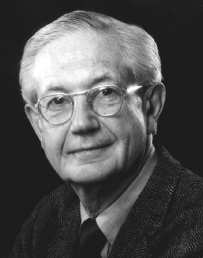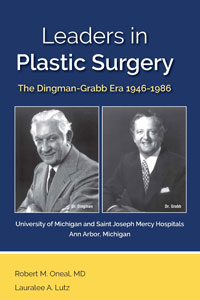
Leaders in Plastic Surgery
Skip other details (including permanent urls, DOI, citation information): This work is licensed under a Creative Commons Attribution-NonCommercial-NoDerivatives 3.0 License. Please contact [email protected] to use this work in a way not covered by the license.
For more information, read Michigan Publishing's access and usage policy.
CHAPTER THREE: Creation of the Section of Plastic Surgery in the University of Michigan Department of Surgery
The narrative continues with the background story of the formation of the University of Michigan (UM) plastic surgery section finalized in 1964. Then follows discussion of the growth of the section up to Dr. Dingman’s (ROD) retirement as section head in 1975 and Dr. Grabb’s (WCG) succession.
Although there was a plastic surgery residency at Saint Joseph Mercy Hospital (SJMH) affiliated with the Department of Surgery at the UM, there remained a long road ahead to finalizing a Section of Plastic Surgery within the surgery department at the UM Hospital (see Photo 13).
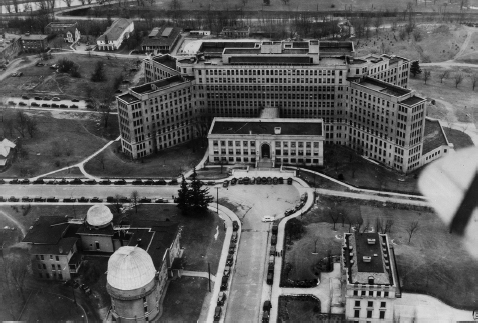
There was resistance to its formation because some in the surgery department felt that the most significant plastic surgery procedures could be done by well-trained general surgeons. There was also resistance from the otolaryngology (ENT) department and the oral surgery section within the Department of Surgery.
In 1959, Dr. Charles Gardner Child III (Photo 14) became chairman of the Department of Surgery following the retirement of Dr. Coller in 1958. This created an opportunity for Dr. Dingman to pursue the idea of a Section of Plastic Surgery within the UM Department of Surgery. As far as the American Board of Plastic Surgery was concerned, the residency was already established through the program at SJMH and it was the university issue that had to be finalized. Owing to Dr. Child’s previous administrative experience at both Cornell and Tufts Medical Schools, prior to coming to the UM, he had gained appreciation for important contributions to teaching, research, and patient care that a well-organized Section of Plastic Surgery could provide. He facilitated discussion between Dr. Dingman and Dr. Walter Work, chairman of otolaryngology, and Dr. James Hayward, chairman of oral surgery, all of whom had strong personalities. The relationship with oral surgery was particularly complicated because of some residual resentment over Dr. Dingman’s previous decision back in 1952 to reject the offer of chairmanship of oral surgery. It took an extended period of meetings, conferences, and faculty votes during the years from 1960 to 1964 to achieve the compromises necessary to allow formation of the Section of Plastic Surgery in early 1964. Dr. Dingman was then appointed associate professor of surgery and section head of plastic surgery. The existing residency training program at SJMH was fully integrated into the section and remains an integral partner in the UM plastic surgery training program to this day.
The “grand compromise” among the plastic surgery, oral surgery, and ENT that was worked out under the guidance of Dr. Child was a major factor in plastic surgery becoming an official section within the Department of Surgery. The agreement contained the following compromises: plastic surgery was to assume the care of all infants with primary cleft lip deformities admitted to the UM Hospital; palate repairs were to be divided evenly between plastic and oral surgery; plastic surgery and ENT would alternate call in the emergency room for facial soft tissue trauma and fractures; and oral surgery was to be called for isolated mandibular fractures and to share in the care of patients with multiple fractures when the mandible was involved. Recalling Dr. Child’s wise mediation over this originally seeming insolvable conflict makes one realize how important it is to strive for compromises that can result in a win-win solution. What was achieved was a grand outcome: The Section of Plastic Surgery at the UM.
Early History of the New Section of Plastic Surgery at the UM
Dr. Grabb continued as an assistant professor at the university after the section was formed and also maintained his private practice at SJMH. He was a very active and productive faculty member along with Dr. Dingman in the training of the residents. The residency program within the newly formed section was originally approved for two trainees per year. Dr. John Tipton (Photo 15) had started the residency at SJMH in 1963. In 1964, he was to become the second-year resident at UM. Late in 1963, Dr. Dingman had called me at 6:00 a.m. in Omaha, where I had taken a teaching position in general surgery at the University of Nebraska having completed my general surgery residency. He told me that he had another opening for the residency program now that the section had been formed and offered me a position (Photo 16). I accepted and joined Dr. Don Davis (Photo 17), who had been appointed to the preexisting SJMH program, as a first year co-resident. In 1966, Dr. Dingman expanded the program to three trainees per year. Frequently, there was a Ford Hospital plastic surgery resident for a six-month rotation and an international fellow for six to twelve months.
The first offices and clinic of the university program, after the section was officially formed, were located in the North Outpatient Building (NOB; see Photo 18). This was a small building directly north of the main hospital, and it was originally a readjustment center for returning World War II veterans. We have a copy of the list of “essentials” that Dr. Dingman made for establishing the new office: a key, a name on the door, paint on the walls, a Dictaphone, and a rack for forms. These minimal requirements were a big step-up from his previous office at the university, which had consisted of a coat rack with a shelf on top to store charts and books. There were two main office rooms, both of which had previously been bedrooms. One was Dr. Dingman’s office and the other a resident/faculty office for six residents, two faculty members, and a nurse. There was a secretarial office in between.
Lauralee Lutz became the section head secretary in 1968 and loyally continued in the position for twenty years. She acquired the affectionate nickname, “L3” (Photo 19). There were also two patient-examining rooms across the hall with a part-time registered nurse who helped with patients during office hours. Dr. Dingman was a stickler about personal appearance. One of his famous admonitions was, “If you are a professional, look and act like one.” His recommendations to achieve that included the following: no facial hair, press your pants, get periodic haircuts, clean white coat at all times, wear a shirt and tie, and no Hawaiian sport shirts (ever). The “no facial hair” was gradually modified as social norms changed but he continued to demand shined shoes. One of L3’s most vivid memories of our time in the NOB was seeing the mandatory shoe shine box being shared by both residents and faculty polishing their shoes.[1]
Dr. Wexler’s (resident, 1970–72) recollections of L3:
Our lovely secretary Lauralee Lutz was the pivot and the anchor of the section life. She took care of everything needed and I knew, as the rest of us residents did, that we could bring to L-3 any question or problem and she would come with the appropriate solution—after discussing it “with the authorities” . . . Once I mentioned to her that a recommendation letter ROD wrote for me was beautifully written, and L-3 said: “Well, actually I wrote it!” . . . “How come?” I asked. “Well,” she said, “it is rather easy, I, sit backward, pretending I am ROD himself dictating the letter and the letter is being printed by itself! Simple, you see???!!!” Of course, ROD made slight corrections and added his impressive signature. L-3 brought much kindness and gentleness to her office with her love to everything and everybody around her with the beloved amaryllis on her desk, and the globe map in which every former resident and fellow was marked with a little flag.[2]
The plastic surgery section, on the first floor of NOB, was one of three other clinical services and offices in this revamped building. A well-baby clinic was next to us on the first floor, and around the corner near the library were emeritus professors’ offices for Dr. Bruce Fralich, longtime head of ophthalmology, and Dr. Henry Ransom, who had been acting head of the surgery department. On the second floor were the allergy department and several psychology and psychiatry offices.
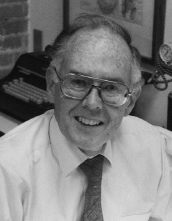
The basement housed the Department of Medical Illustration, headed by Gerald Hodge (Photo 20).Denis Lee and several other talented artists were also members of that department. We had a close liaison with them on many of the papers and books that plastic surgery was involved in. Often, one of them would join us in the operating room (OR) to gain a more accurate vision of the anatomic structure or surgical manipulation they would be depicting. Over the years, a strong sense of mutual respect had developed between the two services. Dr. Dingman had always appreciated artwork and the artistic spirit. The origins of the medical sculpture program are documented from annual section reports 70–71 and 72–73 written by Dr. Dingman:
In early spring, 1971, a Medical Sculpture Service was begun in cooperation with Mr. Denis Lee [Photo 21] and Professor Gerard P. Hodge of the Department of Medical and Biological Illustration. This new service offers prosthetic correction for facial disfigurement, particularly in patients who are not considered as operative candidates because of age or extent of their facial deformity. Patient referrals are expected from all departments and sections of the Medical Center as well as from outside physicians. Already Mr. Lee, who had received special training in constructing medical prostheses, has created prostheses for patients lacking a nose, ear, part of a cheek, partial skull defect, and one patient with pectus excavatum. In five months, Mr. Lee had seen twenty-four patients. By 1973, Mr. Lee had treated patients from all the UM affiliated hospitals and from others in the Midwest area. During this fiscal year Mr. Lee constructed 34 prostheses.[3]
The program continued successfully within the plastic surgery section for many years and was appreciated by many grateful patients.
In 1976, the plastic surgery offices moved to the seventh floor of the main outpatient building, which is now the Med Inn (see Photo 22). The offices occupied an entire corridor. Plastic surgery shared the floor with general surgery, thoracic surgery, and the Department of Surgery offices. In this new location, there was a large waiting room that was decorated much like a living room—a way to help make patients feel more comfortable. There were several exam rooms, faculty offices, a minor surgery room, a nurse’s office, and, eventually, an exam room containing a laser to treat hemangiomas. The Reed O. Dingman Library (an acknowledgment of Dr. Dingman’s commitment to the heritage of plastic surgery) occupied its own room and contained a wide selection of the important plastic surgery texts, journals, and a panel of famous quotations (see Photos 23 and 24). It was popular and used frequently by faculty, residents, and students. The contents of the library have since been moved and combined with the Department of Surgery library in the Taubman Building.

Lauralee Lutz, our long-standing secretary of the section, continued to be the “power behind the throne” to both Drs. Dingman and Grabb. She now had some secretarial help as the clinic size had grown and operating schedule expanded. There was great camaraderie among the faculty, secretaries, and residents, and we always had a holiday party. The holiday parties were held in the section offices until a student guest had a little too much wine and we had to move the party locations to private homes (see Photo 25).
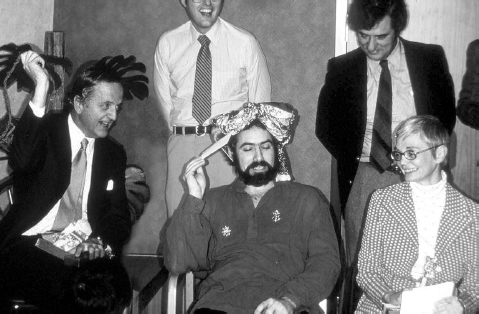
Additional Faculty Appointments to the New Section
Dr. John B. Tipton: In 1965, John opened a practice in Ann Arbor, and his primary teaching activities were at SJMH where he had his private patients. He was an excellent surgeon, very well read, and an original thinker. He was an important part of the teaching programs both in the OR and in conferences. He decided to start a practice in Palm Springs, California, partly for health reasons, and left Ann Arbor in 1969.
Dr. Robert M. Oneal (RMO): When I completed my residency in 1966, Dr. Dingman appointed me as instructor in the Section of Plastic Surgery. I also saw private patients together with Drs. Grabb and Dingman at the 221 N. Ingalls Street office across the street from old SJMH. After three years, I was promoted to clinical associate professor. I eventually started my own practice, with Dr. Dingman’s blessing, in downtown Ann Arbor with an office on the twenty-fifth floor of the Tower Plaza in 1969 and continued my part-time teaching responsibilities.
Ron Wexler (resident, 1970–72) recollected the three faculty members at the time of his training:
I admire the outstanding collaboration among our three staff members, ROD, WCG, and RMO—the King, the Crown Prince and the Prince. I know that the “Section of Plastic Surgery” was not a monarchy, it was a voluntary hierarchy, in which mutual respect, discipline, professionalism, and knowledge were the binding glue. ROD, the King. He was a “doer.” He loved operating and I loved working with him. He was open-minded and listened to any remark or suggestion, even from a first-year resident. He was a hard worker. He could work endlessly. When we were at his office, seeing all his patients, embedded in soft evening music, he would eat an olive between cases and around 11 p.m. he would say: “OK boys, you can have the rest of the day off,” provided we were not on call for the emergency room.
WCG was the scholar surgeon. When any of the residents would come up with an idea, he would ask, “Did you check all the literature to see if it had been previously mentioned?” He emphasized, nonstop, the need to be knowledgeable . . . He loved all the fascinating advances in plastic surgery and was thrilled to share it with us. (We all became familiar with WCG’s “Ten Most Wanted” list of the classics or recent literature, and then a couple of months later, he would come out with the second list to keep us on our toes [see A-8 in the appendix for these lists].)
Ron Wexler continued,
RMO was an elegant surgeon. As he was just a bit older than us all, we looked at him as a friend and brother. He was very prudent and meticulous in his surgery and I remember once his rhinoplasty took a bit longer than expected. He looked at me and said, “Ron, remember, in one year nobody will ask you how long did the operation take, but everybody will ask you how the result is!” I used this saying hundreds of times since, in my teaching [see Photos 26 and 27].[4]
Dr. John M. Markley Jr. joined the UM faculty and my practice in 1974. I had known John both as a medical student and as a beginning surgical resident and had followed his career as a combined plastic surgery resident at Stanford under Dr. Robert Chase and then during a hand fellowship under Dr. William Littler in New York City. Dr. Dingman encouraged John’s return to Ann Arbor as he felt additional faculty was needed due to rapid growth of the section. I was thrilled that he wanted to come back to Ann Arbor, and so we teamed up as partners in our office in the Tower Plaza. Dr. Markley immediately became an important member of our faculty (Photo 28). His surgical skills and expertise in hand and microsurgery made him an essential addition to the program. He was also obviously a self-starter, as in John’s own words, “During my Stanford residency in 1970, [during] a 6 month lab rotation, I taught myself microvascular technique in the empty but still equipped micro lab Harry Buncke left behind when he left Stanford. I visited him a couple times at his lab in Mountain View, and used some written material he had generated, and just taught myself, doing rat kidney transplants, end-end arterial, venous, and ureteral anastomoses. This led to doing a rat renal transplant immunologic study with the transplant surgeon at Stanford (Lucas) which was published in 1970.”[5]
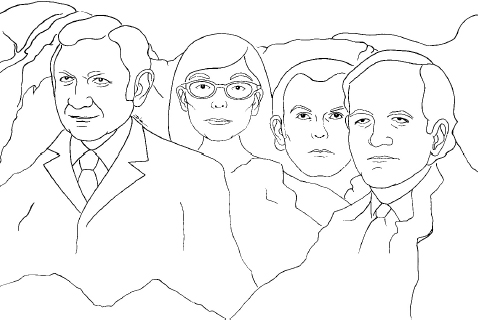
Two Interesting Aspects Unique to Early Years of the Residency Program
1. The Michigan-Maryland Connection
Dr. Robert Buxton had been a professor of general surgery at the UM and was recruited to become the chief of surgery at the University of Maryland. He had been one of the most popular faculty members, and everyone spoke highly of him at Michigan. The medical students at the time also knew him, and he, therefore, attracted several of them to Maryland for general surgery residency, including Dr. David Dingman (Dr. Dingman’s son) and Dr. Ted Dodenhoff. This was crucial to Ted’s future as he recalled:
I first met Dr. Dingman through his son Dave, my close friend in Medical school. I knew him as more of a second father figure in my life at a time when I had no clue what kind of a career I was going to have after medical school. Once Dave and I reunited in General surgery at the University of Maryland, we began to realize that the future of General Surgery was going to be bleak and Plastic Surgery offered a better future. Luckily, the program at Michigan was one of the best and the only place I had any chance to get into because of the late decision to seek a residency. I’m sure I got in mainly because Dr. Dingman knew me and felt confident that I would work out well in the program.[6]
From 1969 through 1975, we accepted into the program seven residents who, while training in general surgery at the University of Maryland, came to be interested in plastic surgery training at the UM. They were all very good surgeons and a great addition to the program. While Ted Dodenhoff was one of the residents, the others were Lenny Glass, Tom Hudak, Carl Berner, Grant Fairbanks, Gary Nobel, and Bob Wilensky.
2. Changes in the Board Requirements for Plastic Surgery Training
In 1971, the American Board of Plastic Surgery altered its requirement for residency training to include those who had become board-qualified in a surgical specialty other than general surgery. Dr. Dingman was very open and outspoken about accepting the best candidates who he thought could become excellent plastic surgeons. Because of his willingness to offer residency positions in the plastic surgery program to otolaryngologists who had completed their training, Dr. Dingman engendered a lot of criticism from some of his longtime plastic surgery friends.
Dr. John O’Connor (1972–74), who had his boards in otolaryngology and dentistry, was the first of these residents from other surgical specialties to enter the UM plastic surgery residency program. Others who entered the program between 1973 and 1986 included Drs. Dick Lawrence, Haskell Newman, Merle Olesen, Jack Gunter, Mike Watanabe, Erlan Duus, Richard Anderson, and Dick Pollock (all otolaryngology), while Drs. Robert Gilman (otolaryngology and dentistry), Bruce Novark (oral surgery), and Biff McCollum (orthopedics) rounded out the group. These highly trained specialty surgeons provided a unique experience for our faculty and the other residents who had not had this additional training. We valued their expertise in all aspects of dentistry and head and neck surgery, especially in rhinoplasty, facial fractures, and head and neck cancer treatment, as well as Dr. McCollum’s expertise in the management of hand and wrist fractures.


